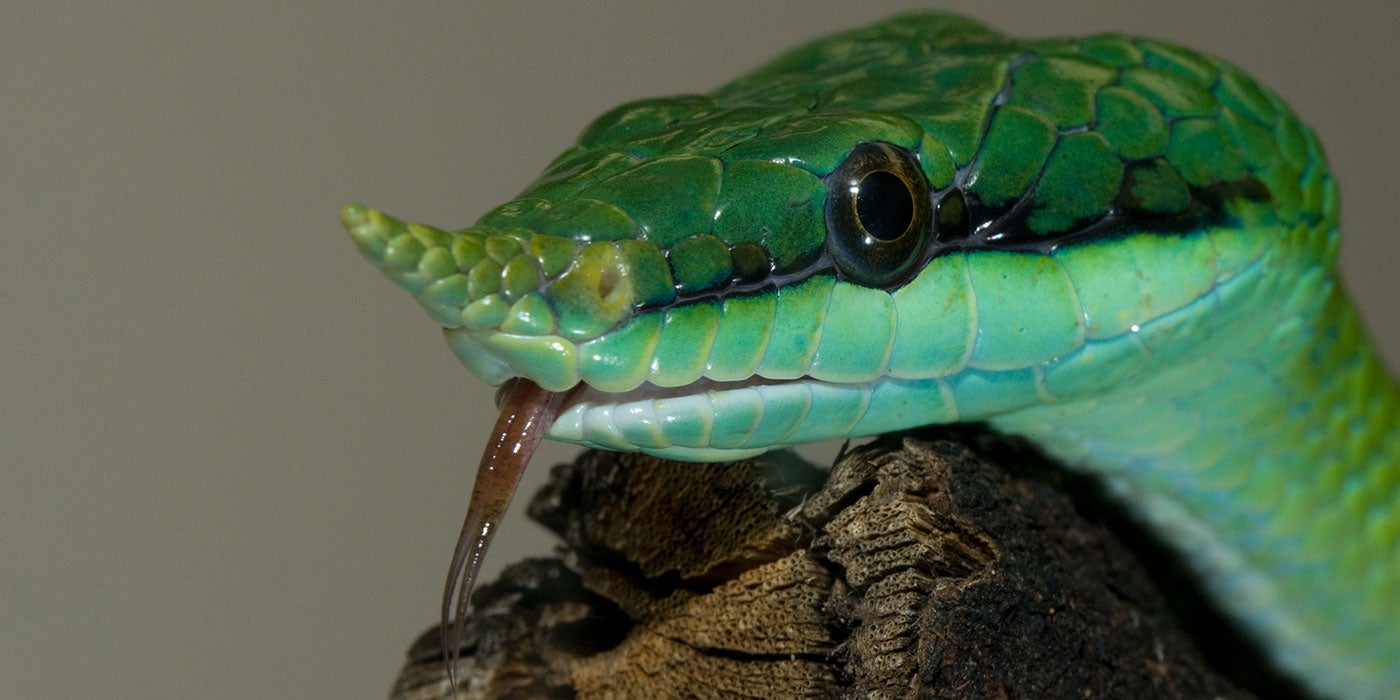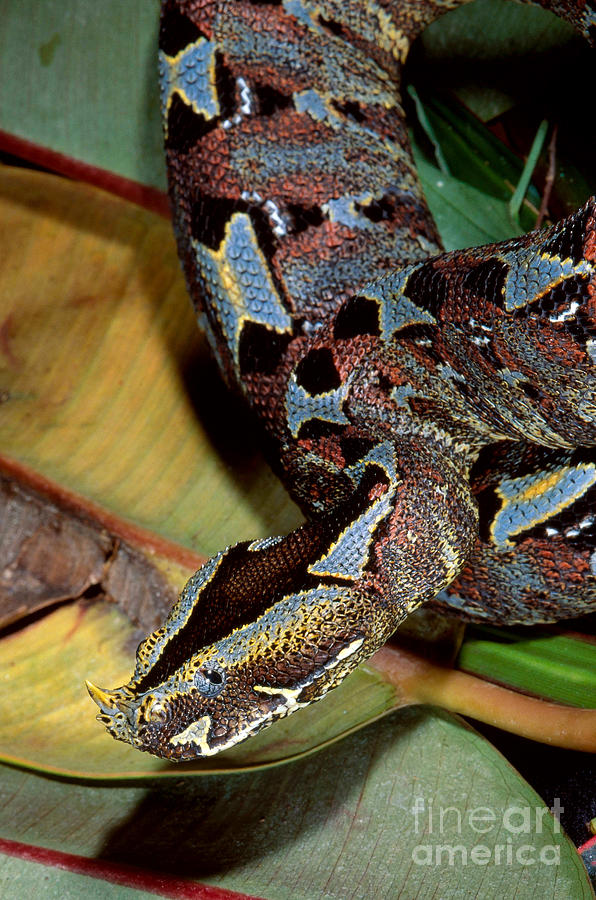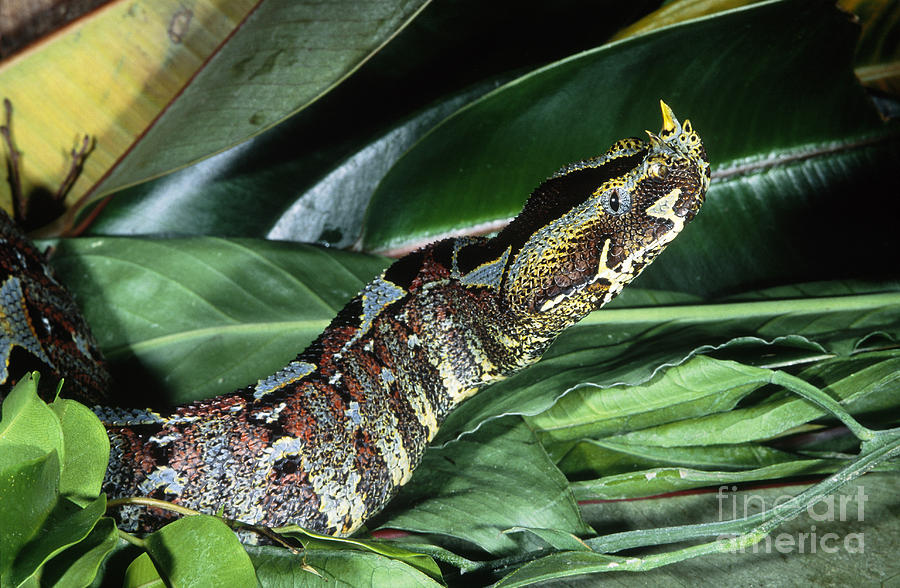
CalPhotos Bitis nasicornis; Rhinoceros Viper
Common names Its common and historical names include butterfly viper, rhinoceros viper, river jack, [7] [5] rhinoceros horned viper, horned puff adder [8] [3] and rhinoceros puff adder. [9] Americo-Liberians apparently call adult "puff-adders", such as the B. nasicornis, but also the B. gabonica (gaboon viper), cassava snakes. [3]

Rhinoceros Viper Virginia Zoo
Discover the captivating world of the Rhino Viper, a venomous snake species with horn-like scales. Learn about its habitat, behavior, and conservation status.

Rhinoceros snake Smithsonian's National Zoo and Conservation Biology Institute
The Rhino Viper is a snake species known for its remarkable physical characteristics. Its coloration is vibrant, displaying bright greens, yellows, and oranges, which makes it easily recognizable in its natural habitat. This snake also has long, horn-like scales above each eye, resembling the horns of a rhinoceros, hence its name.

Rhino Viper Photograph by Gregory G. Dimijian, M.D.
The rhino viper comes from the BitiI family of reptiles, which is the most perfect scientific name in zoology. This includes other formidable snakes like Puff Adders and the Gaboon Viper. They are found in the swampy forests of western and central Africa, which is how they got the nickname River Jack.

ANI02700393 Joel Sartore
Rhino Viper The river jack snake has a gigantic horn-like scale on the tip of its nose. Continue Reading after the facts. Advertisement Rhino Viper Scientific Classification Kingdom Animalia Phylum Chordata Class Reptilia Order Squamata Family Viperidae Genus Bitis Scientific Name Bitis nasicornis

Rhinoceros Viper Encyclopedia of Life
A large viper species, the Rhinoceros Viper is a venomous snake that are known for their distinct 'nasal horns' and eye-catching pigmentation. Scientific Classification Quick Information Rhinoceros Viper Pictures Gallery Images of Rhinoceros Viper Pictures of Rhinoceros Viper Rhinoceros Viper Images Rhinoceros Viper Photos Rhinoceros Viper Pictures

CalPhotos Bitis nasicornis; Rhinoceros Viper
Found in the forests of Western and Central Africa, the rhinoceros viper, aka butterfly viper, rhinoceros horned viper, horned puff adder, or river jack, is a venomous snake that is renown for its beautiful coloration as well as its nasal horns. Due to exploitation for the international pet trade, hunting and trapping for food, and habitat destruction, these snakes are listed as Vulnerable by.

Vipers are amazing creatures IUCN Viper Specialist Group
Rhino vipers give birth to live young (they are viviparous) and they have a surprisingly small neck leading to an arrow shaped head. Their venom is both hemotoxic and neurotoxic potentially causing internal haemorrhage and cardiac arrest.

Gaboon Viper Photograph by Paul Slebodnick
Description Close-up of the head Bitis rhinoceros has a distinctive set of enlarged nasal scales that look like a pair of horns on its nose. This is a characteristic that it shares with a close relative, B. nasicornis. However, B. nasicornis has a brighter color pattern and a narrower head. [6]

Rhinoceros Viper Africa. Studio Shot Photograph by Grall
The rhinoceros viper (Bitis nasicornis) is a venomous snake species found in sub-Saharan Africa. The rhinoceros viper is a member of the family Viperidae and the subfamily Crotalinae (pit vipers). It is one of the most dangerous snakes in Africa due to its large size potent venom and aggressive nature. Snakes of the Eastern Diamondback Rattlesnake

CalPhotos Bitis nasicornis; Rhinoceros Viper.
The Rhino Viper, found in Sub-Saharan Africa, is a stunning snake known for its unique coloration and stocky body shape. With a maximum length of up to 1.5 meters (5 feet), this reptile is part of the Viperidae family and is widely considered one of the most venomous snakes in the world. Despite its intimidating name and appearance, the Rhino Viper is an important apex predator in its ecosystem.

Rhinoceros Viper Photograph by Mark Kostich
rhinoceros viper, ( Bitis nasicornis ), brightly coloured venomous snake of the family Viperidae that inhabits rainforests and swamps of West and Central Africa. It prefers wet or damp environments and can even be found on plantations. The body is massive with rough and strongly keeled scales.

Rhino Viper Bitis Nasicornis Photograph by Gregory G. Dimijian, M.D.
The Rhinoceros Viper (Bitis nasicornis) is a mesmerizing snake species found in the rainforests of West and Central Africa. With its distinct horn-like scales on its snout and vibrant coloration, the Rhinoceros Viper stands out as one of the most enigmatic creatures in the animal kingdom. In this article, we will delve into the intriguing world.

Rhinoceros Snake Smithsonian's National Zoo
The rhino viper is a venomous snake found in Africa. It is a member of the viper family and is closely related to the puff adder and the Gaboon viper. The rhino viper gets its name from the large, horn-like protrusions on its head. These horns are used to help the snake burrow into the ground.

Rhinohorned Viper African Snakebite Institute
The Bitis nasicornis (or the rhino viper) is a native snake of the vast African tropical forest habitat and is found mainly in central and western parts of the continent. They inhabit humid and swampy African forests and on some occasions venture into woodlands or savannas.

Rhinoceros viper Venomous, West Africa, Rainforest Britannica
The Rhinoceros Viper is a stout, heavy bodied snake that can grow to lengths of 3-4 feet, with females typically growing larger than males. Like most of the vipers in the Bitis genus, the Rhinoceros Viper has a distinctive triangular shaped head. The scales of the snkae are heavily keeled.
